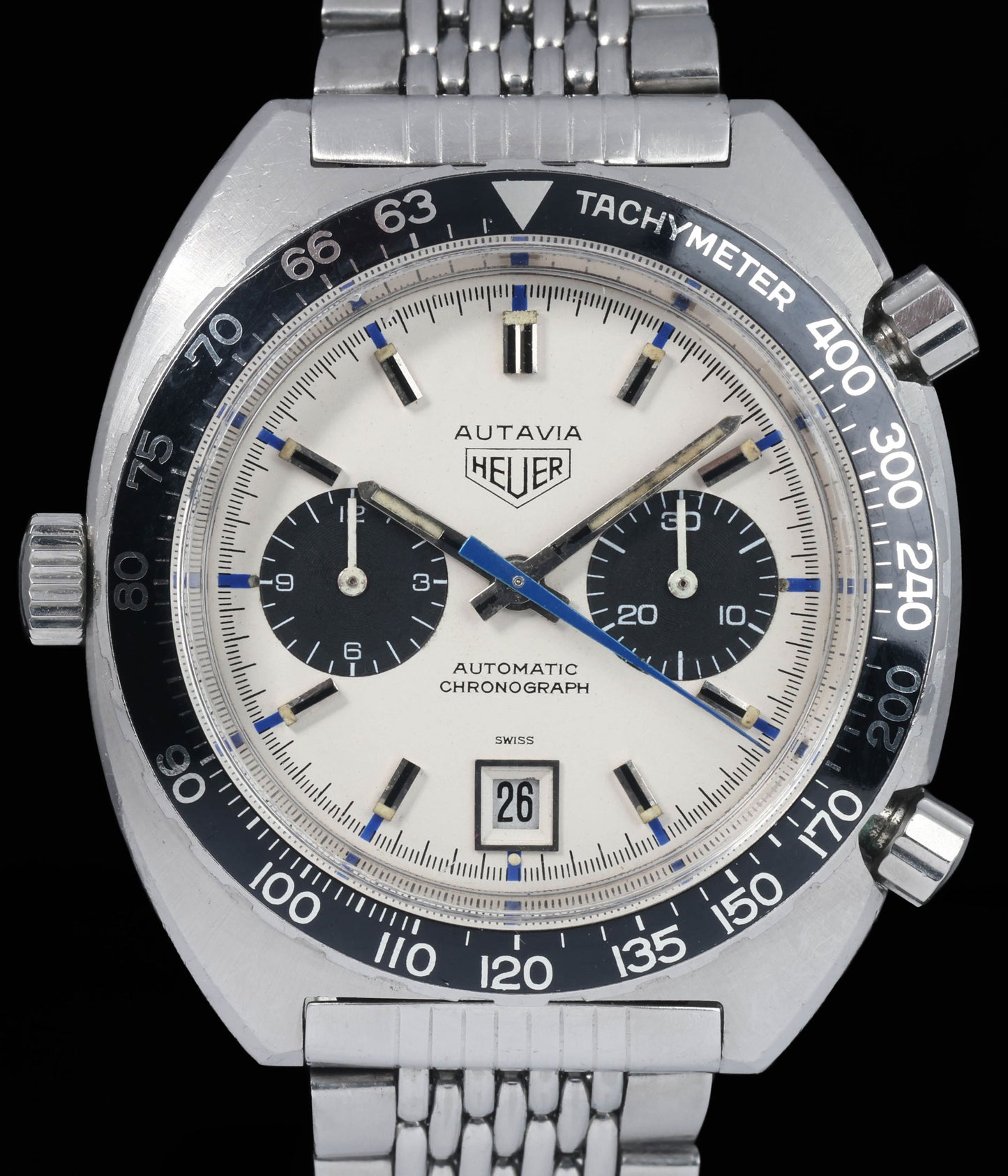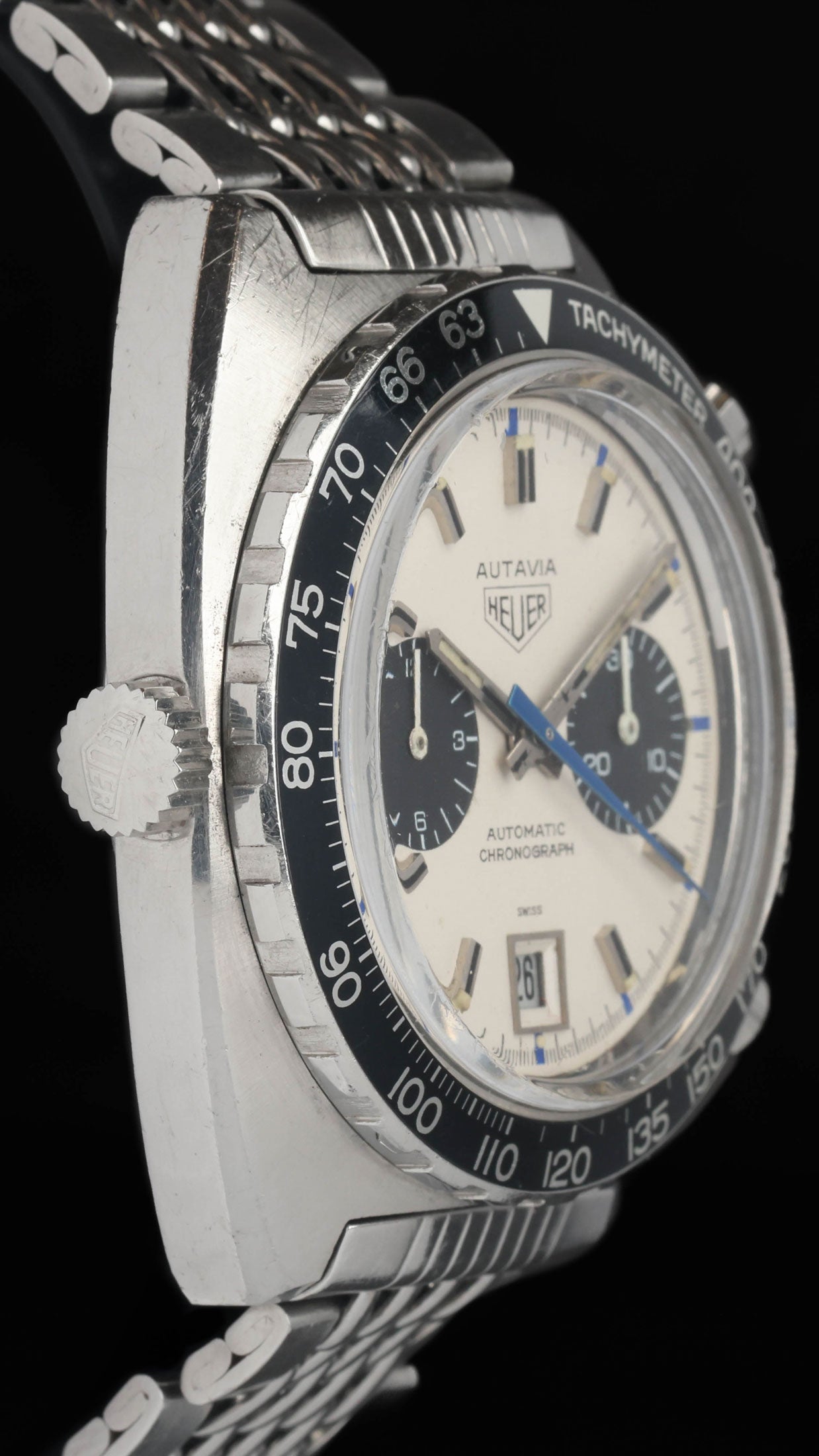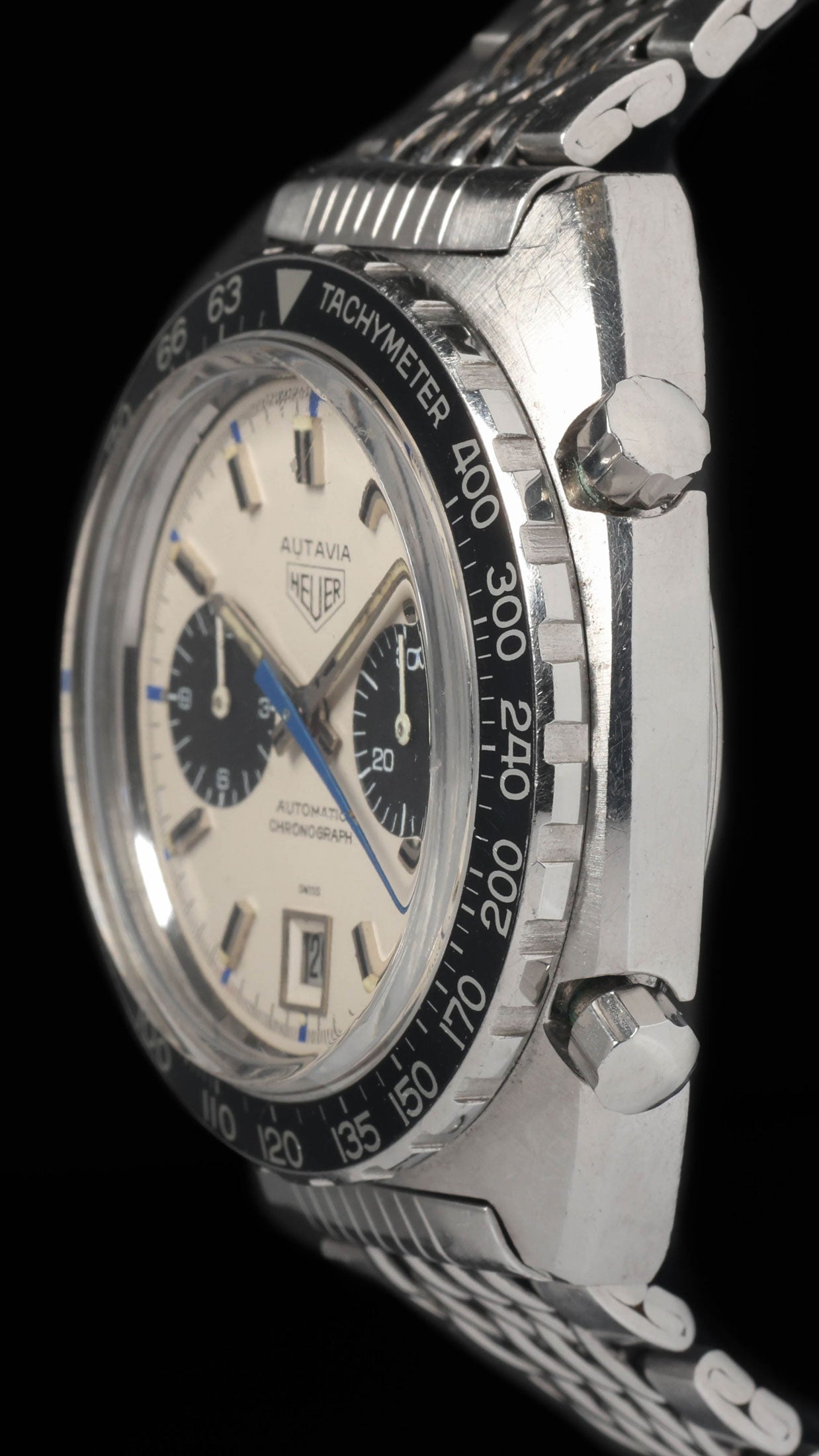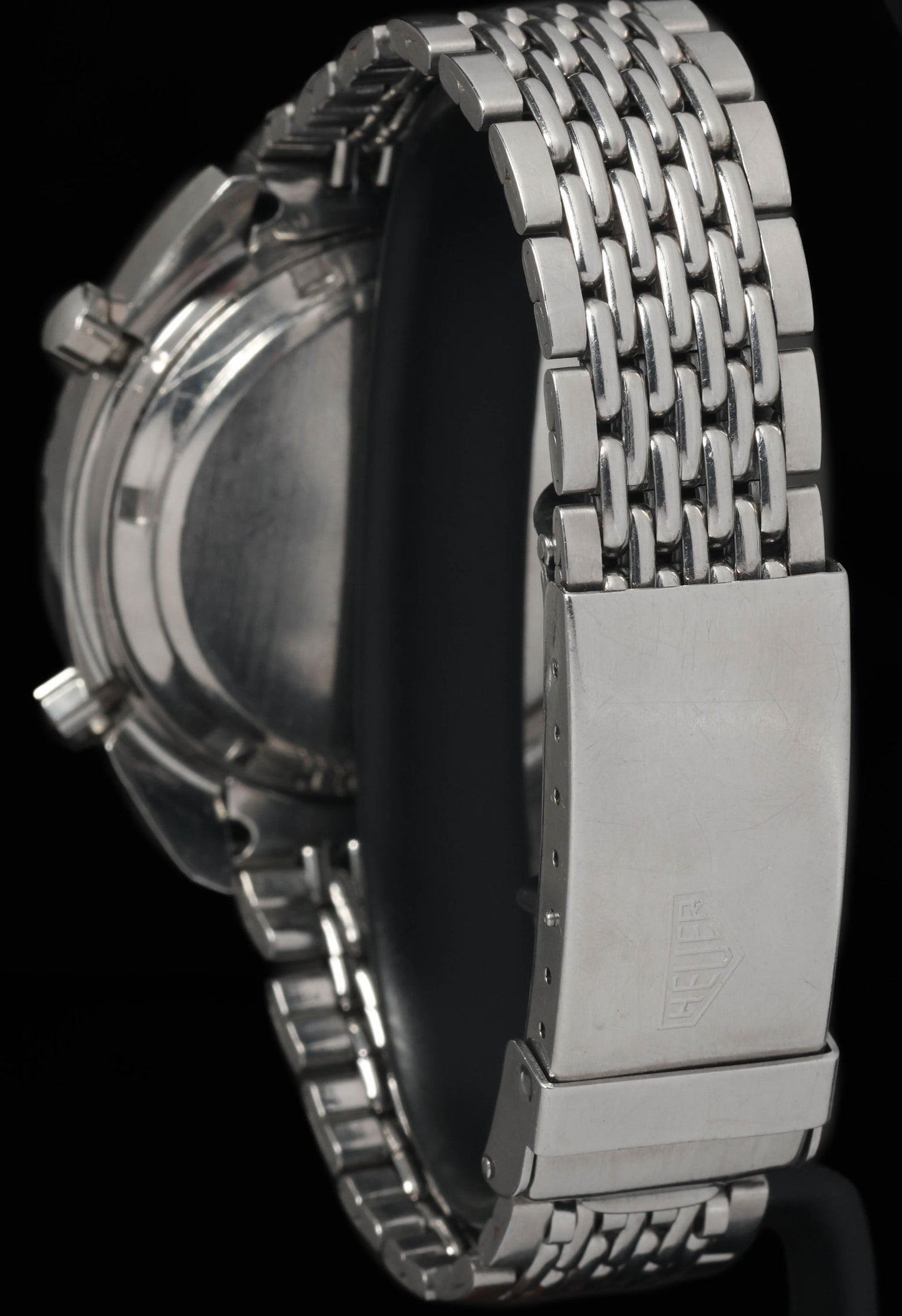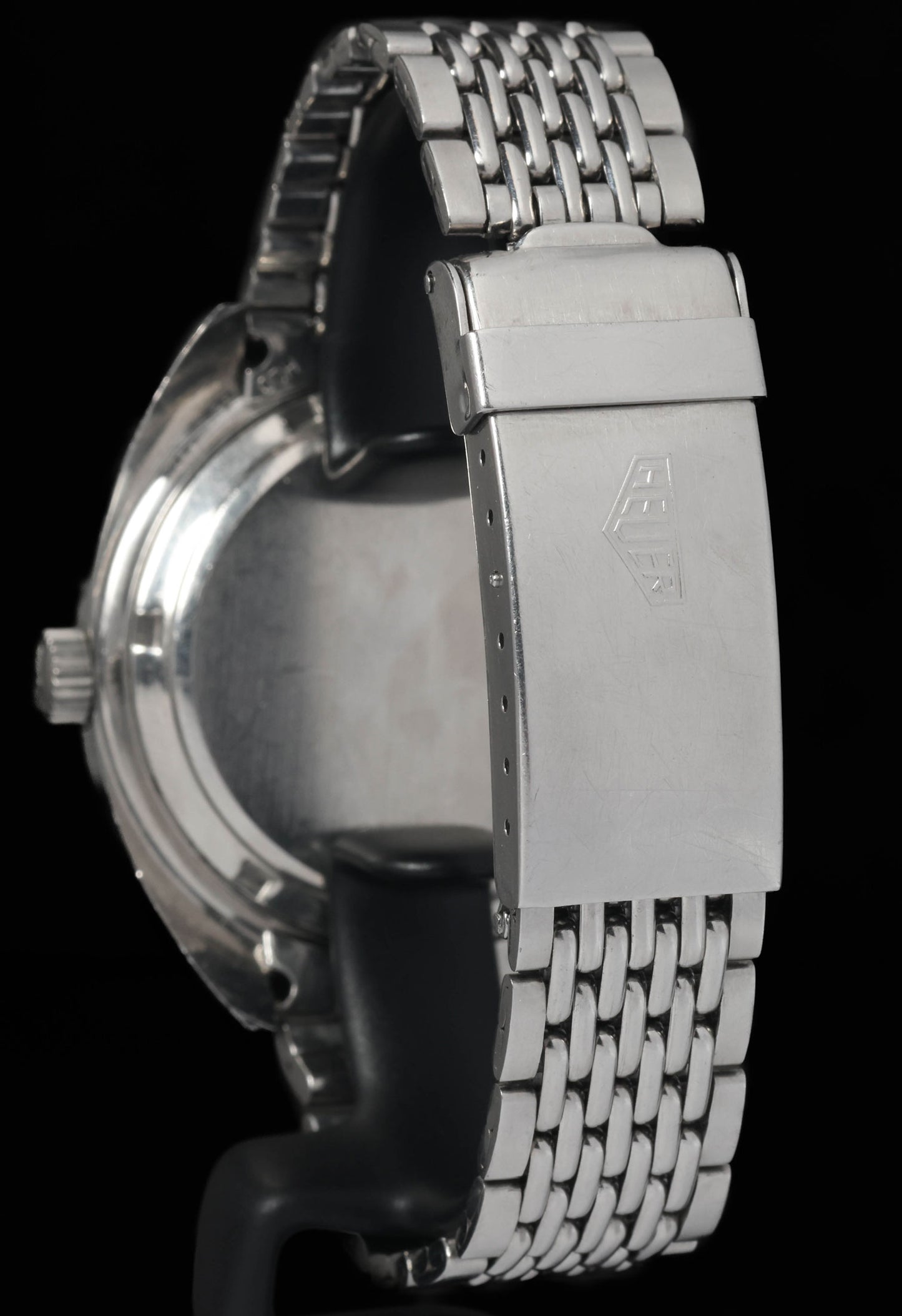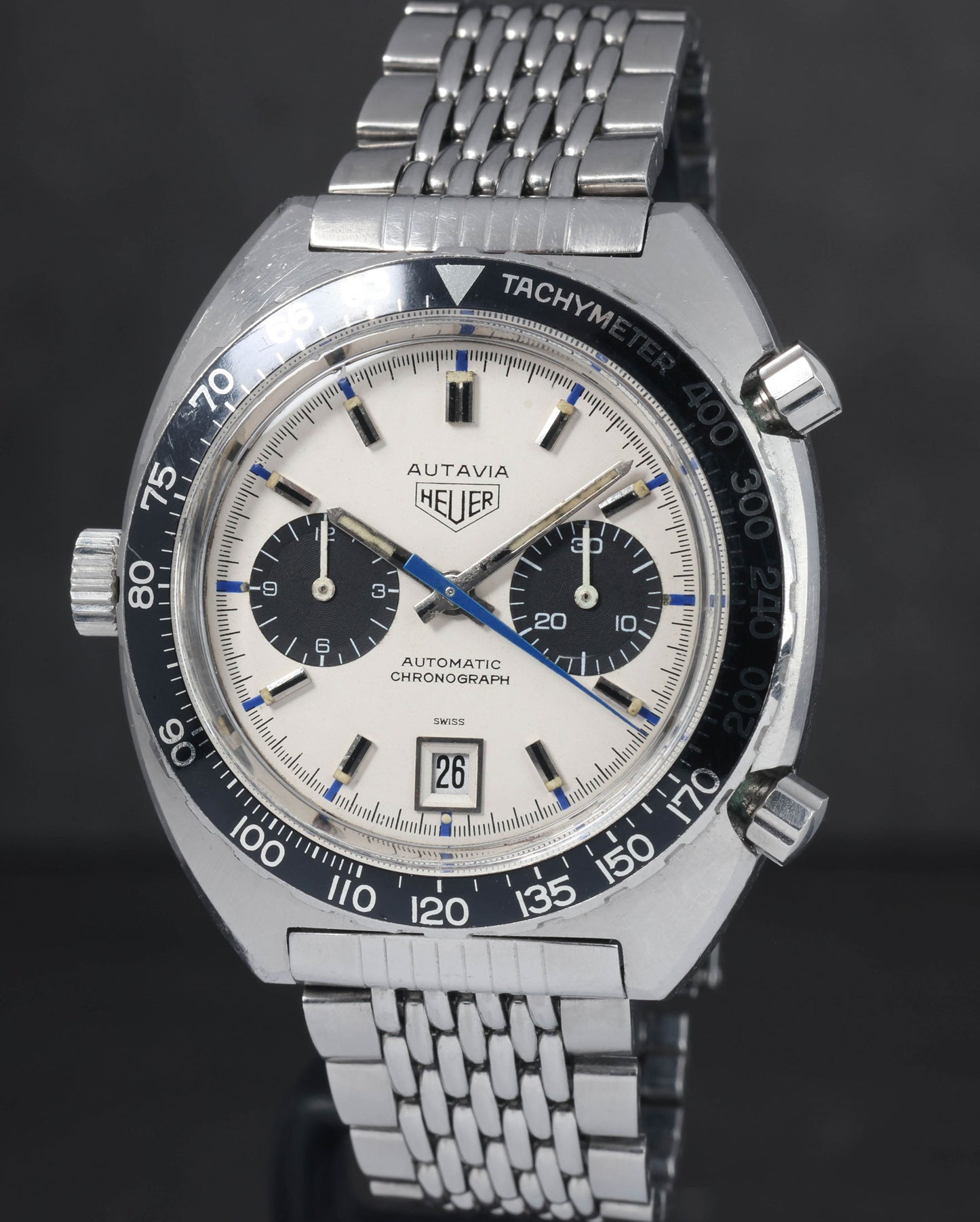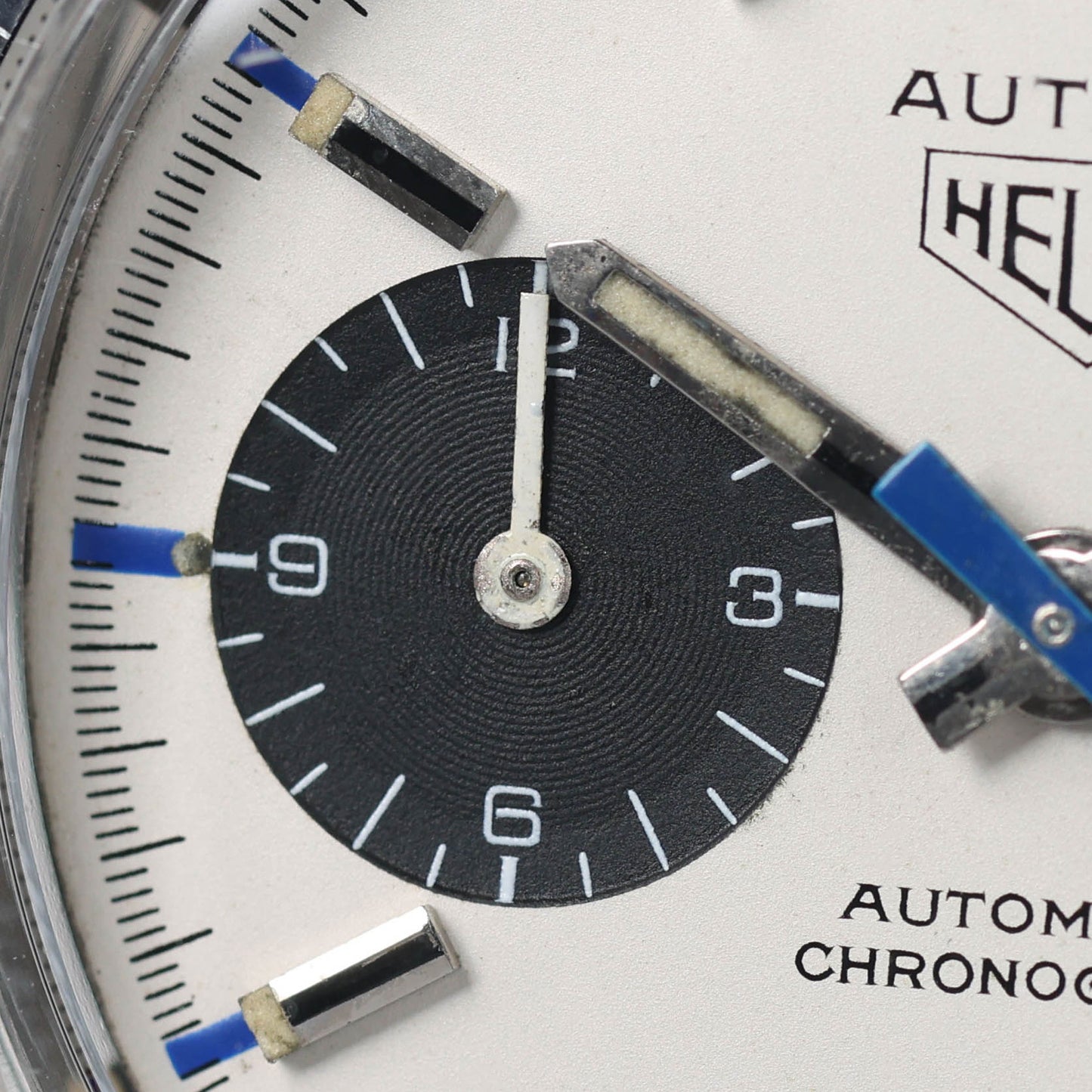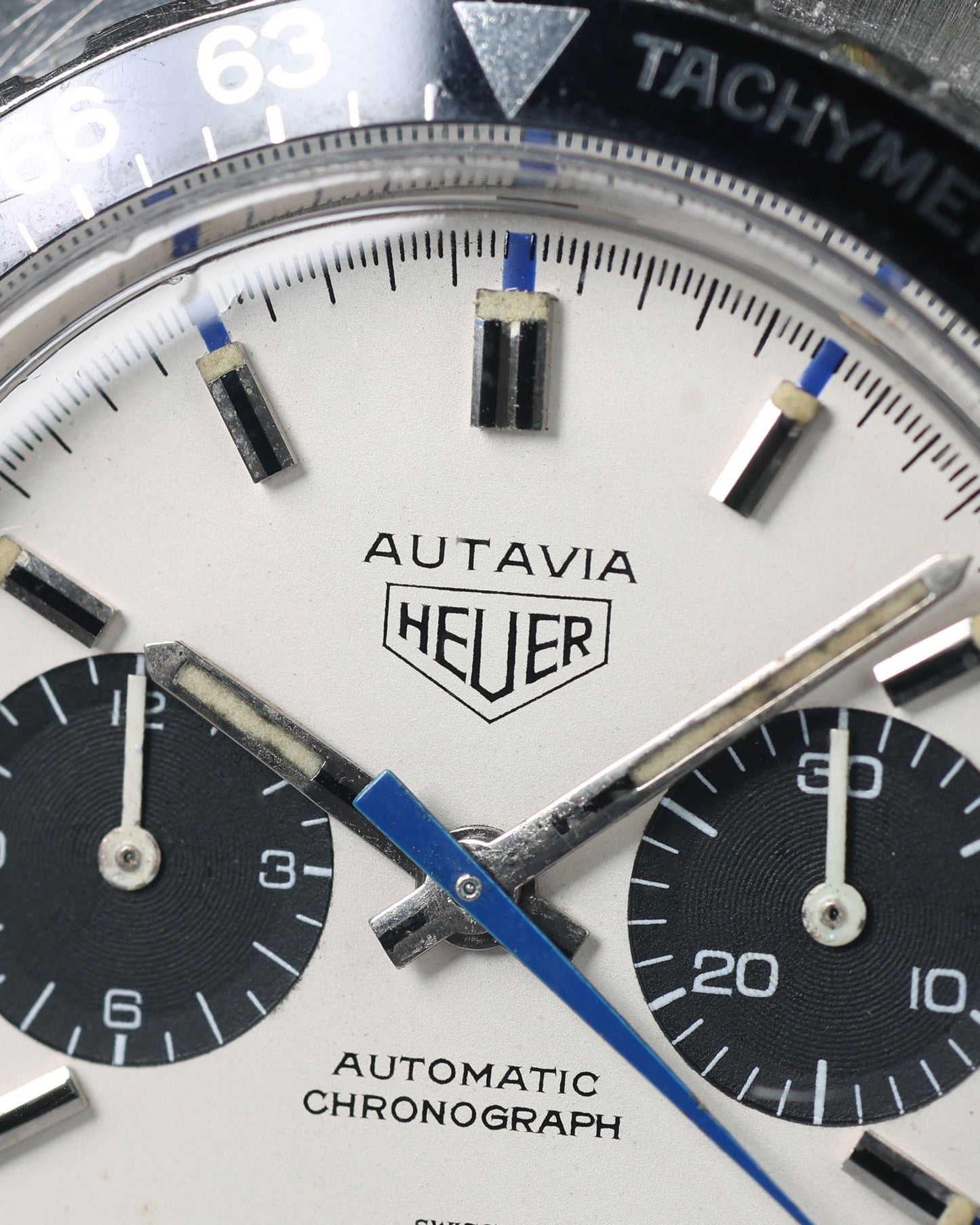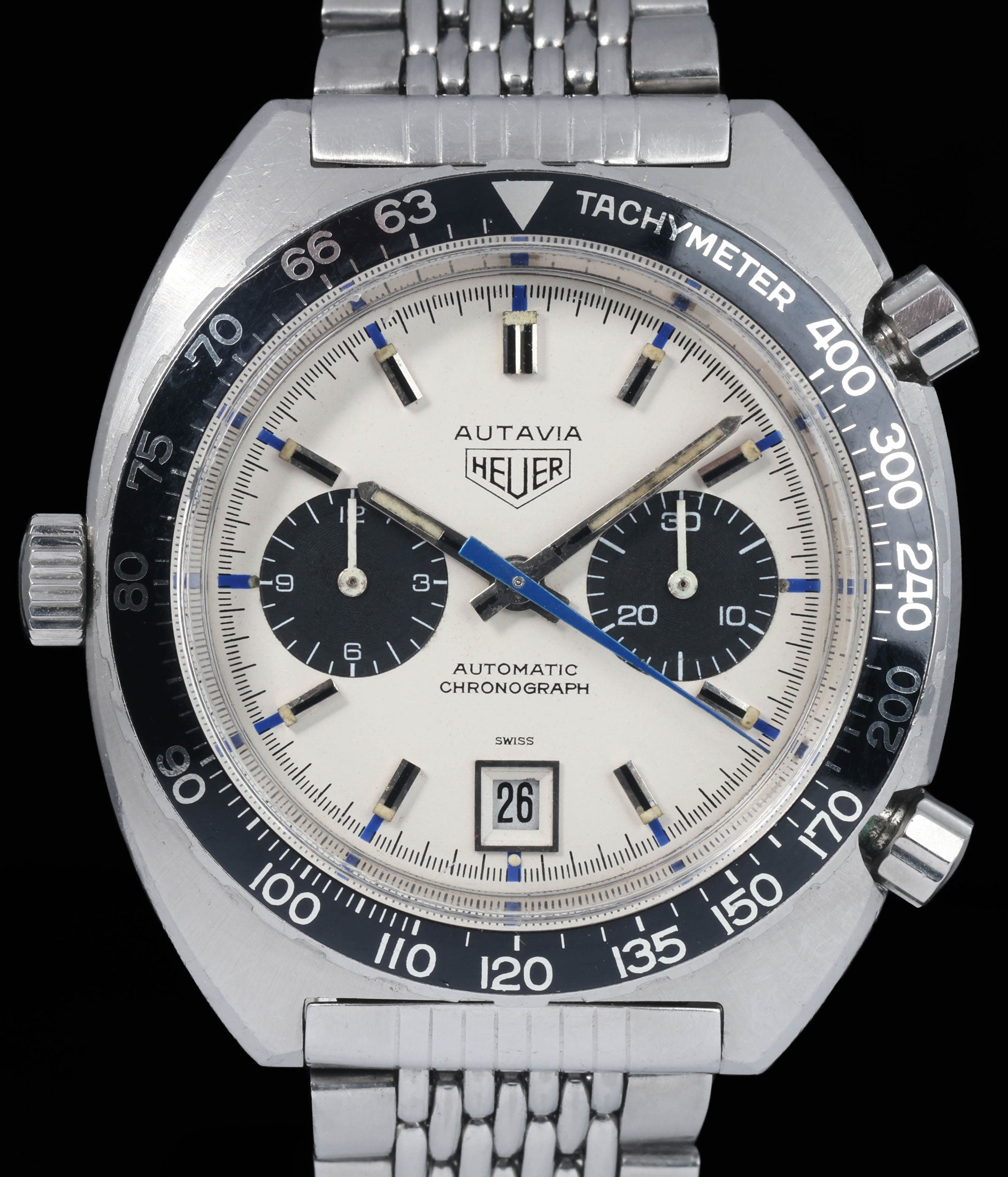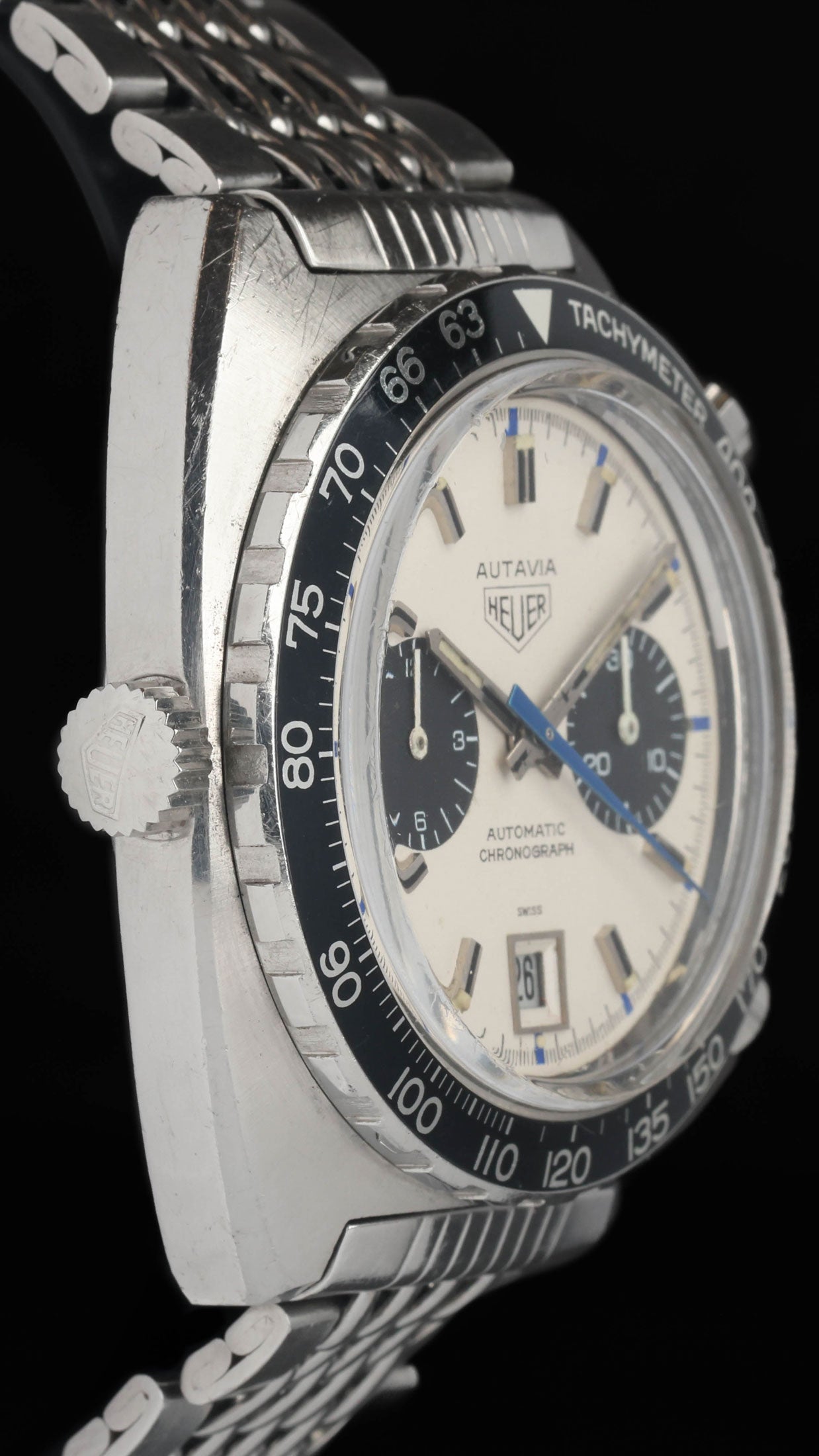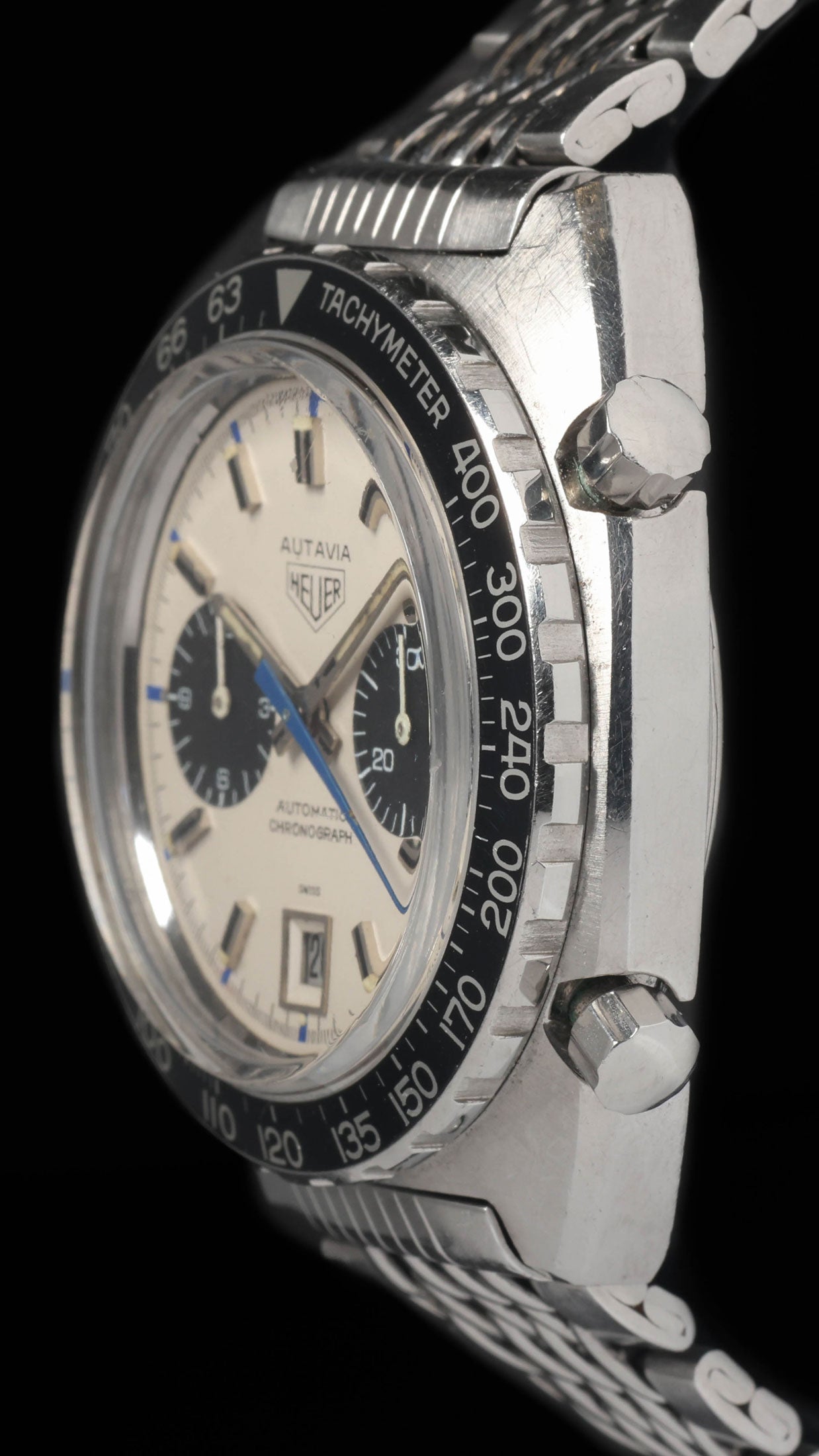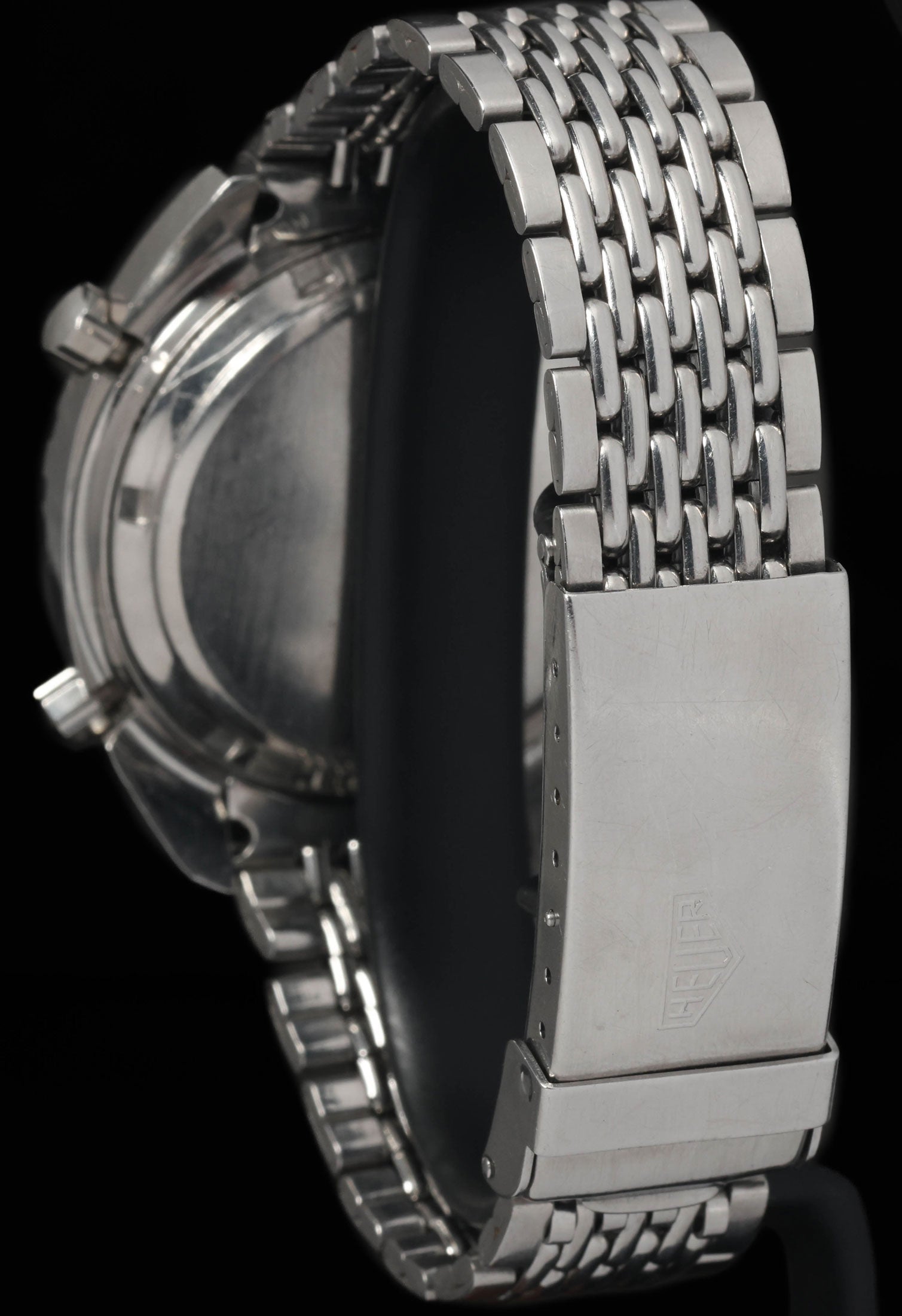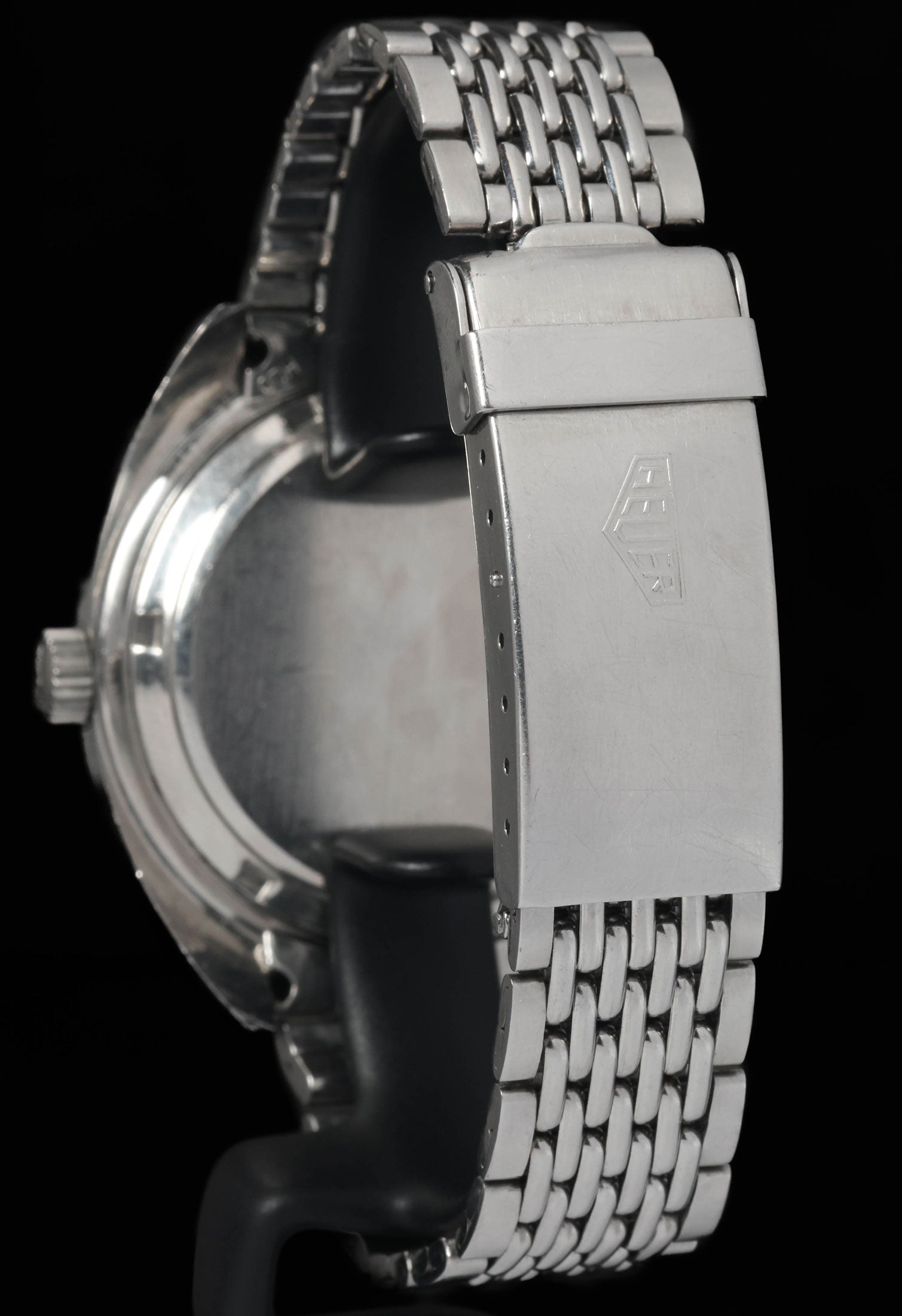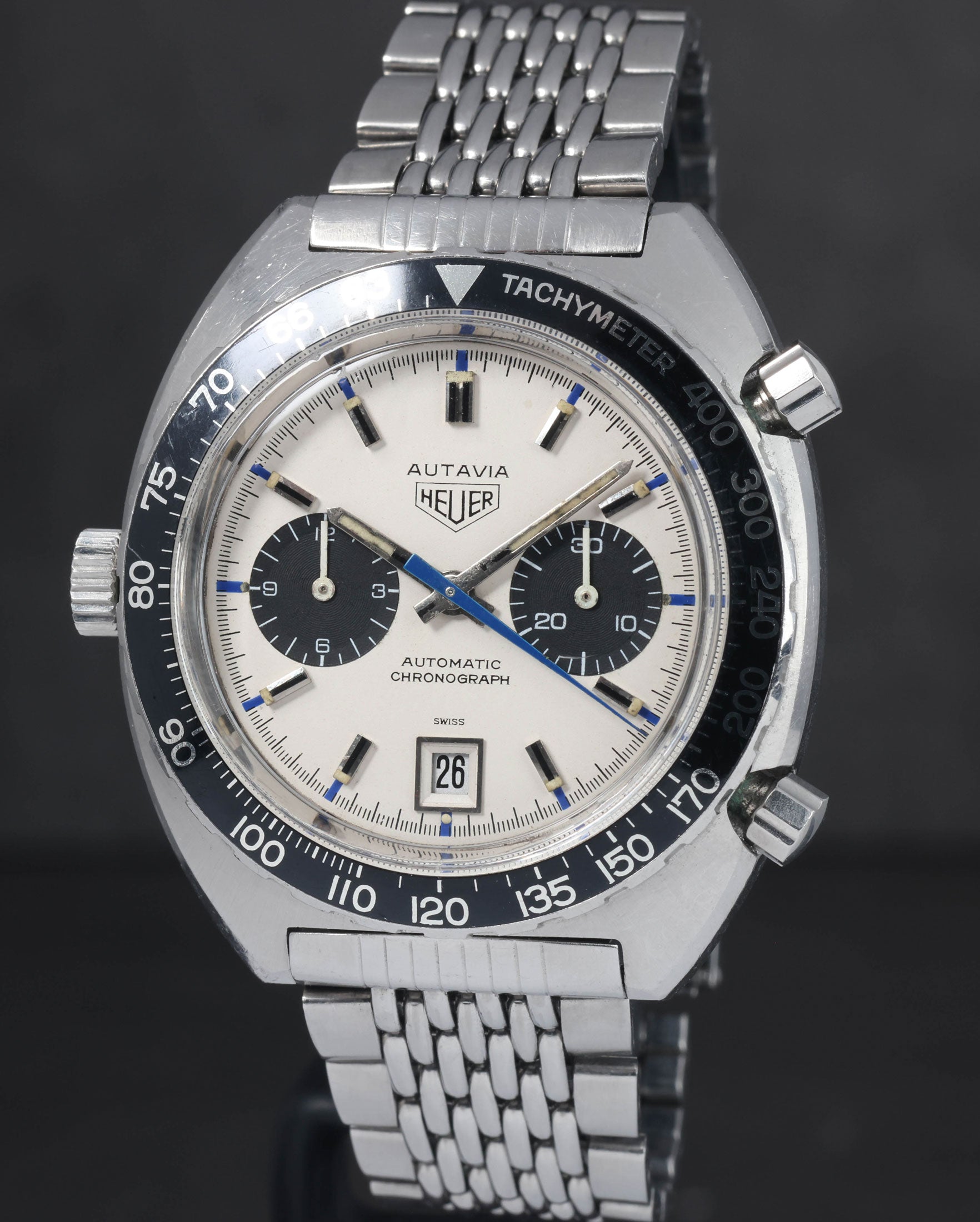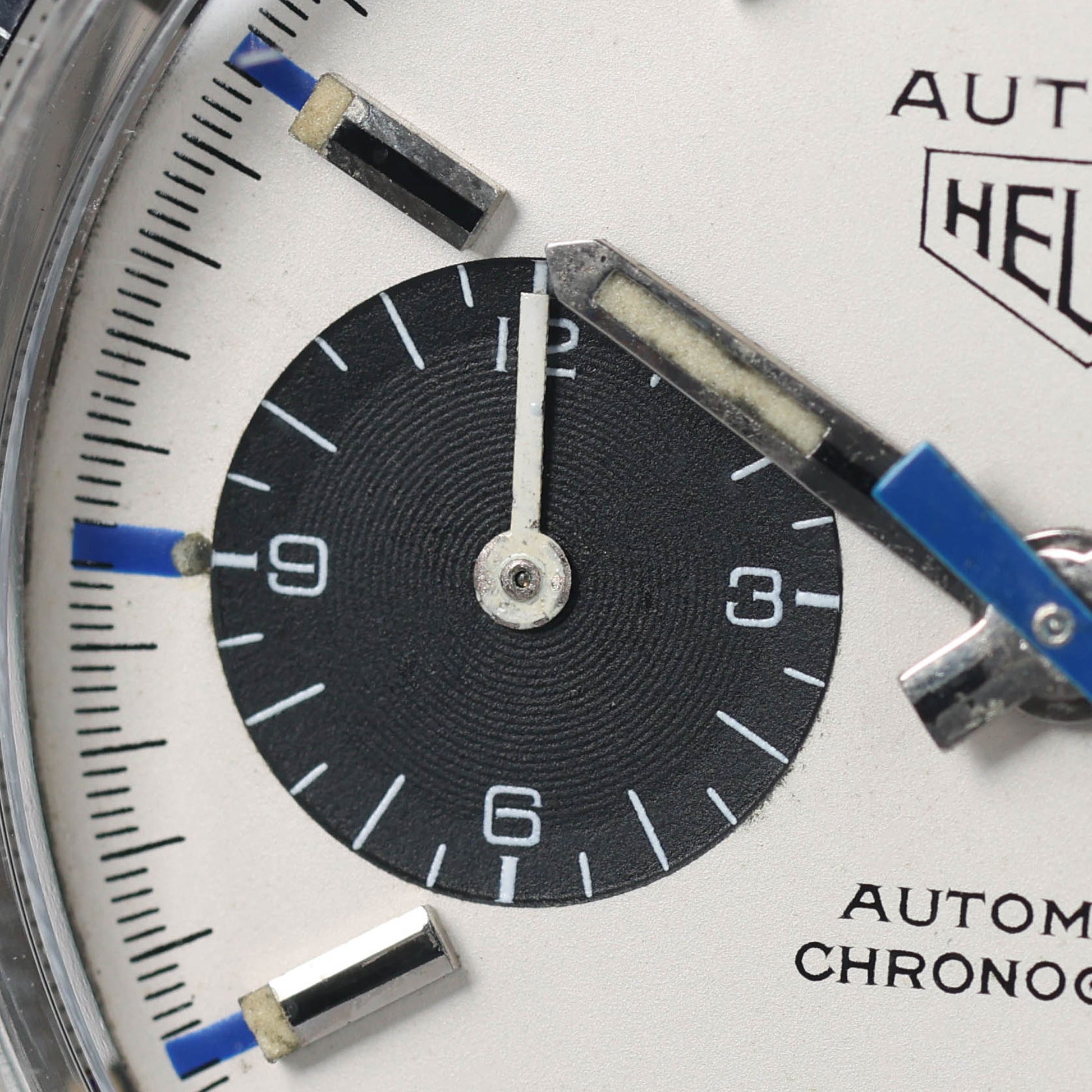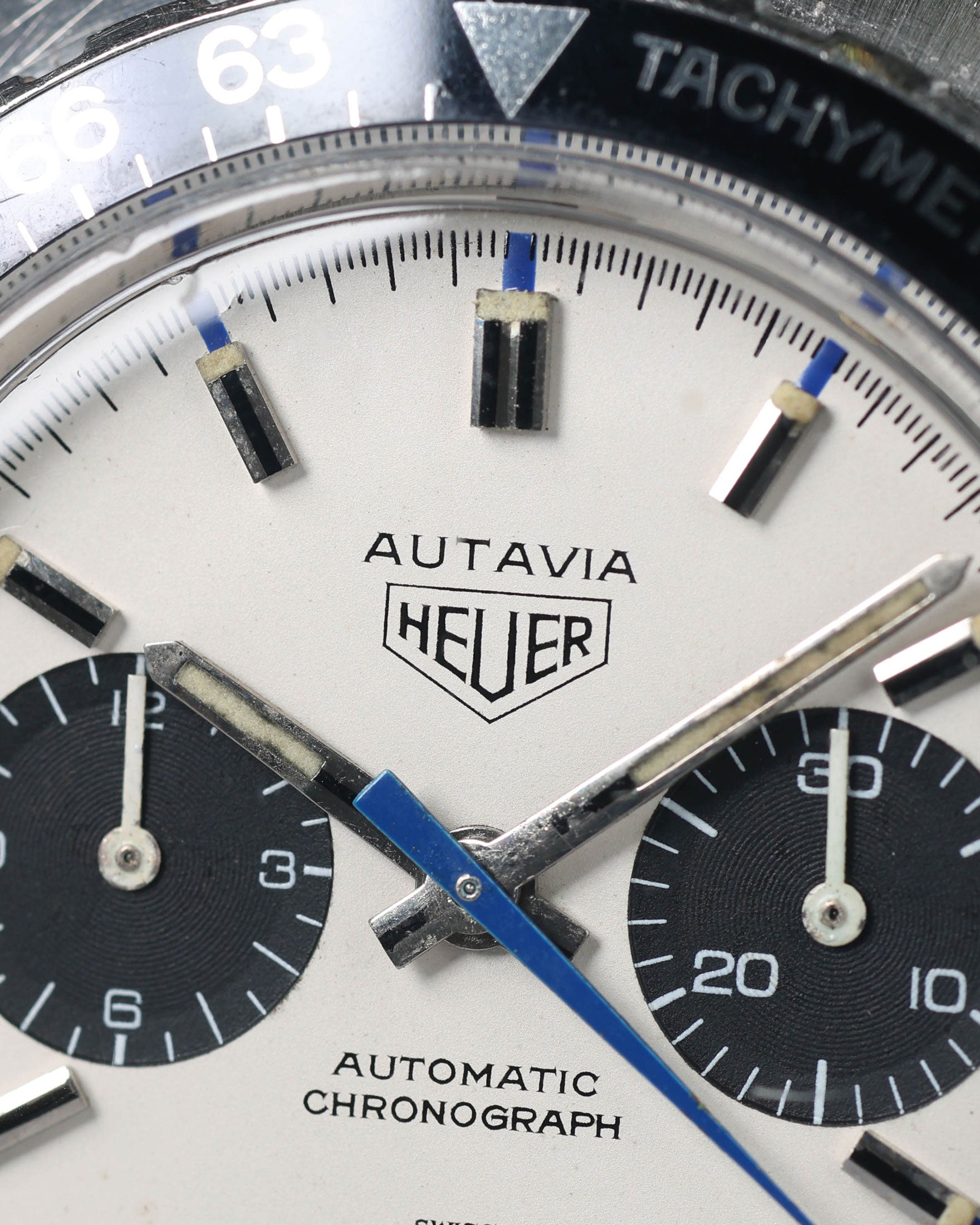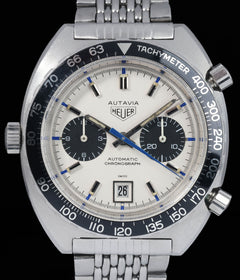Crown Vintage
Heuer Autavia 1163V 'Siffert' 42mm Circa 1970
Heuer Autavia 1163V 'Siffert' 42mm Circa 1970
Couldn't load pickup availability
Heuer Autavia 1163V 'Siffert'
The case is in excellent vintage condition with sharp bevels and clear sunburst brushing. Light surface marks are visible but the case appears unpolished or only lightly refinished. The dial is clean with strong contrast and creamy patina on the lume plots. Hands are original, with light oxidation visible, particularly on the minute hand. The blue chronograph hand is vibrant and correct.
The bezel insert shows expected wear, including minor fading and edge marks, but no cracks. Bezel teeth remain sharp. The crystal has minor scratches consistent with age.
Fitted with its original Gay Frères “beads of rice” bracelet, date stamped 3/69, the bracelet is in good vintage condition with some stretch. The clasp is crisp and correct. Overall, a highly original and well-preserved early Siffert with its correct and valuable bracelet.
Share
Why we love this watch
Why we love this watch
Heuer Autavia 1163V 'Siffert': A Racing Icon in Steel
Introduction
Among the golden era of vintage racing chronographs, few watches capture the spirit of motorsport quite like the Heuer Autavia 1163V—more famously known as the "Siffert Autavia." Named after Swiss Formula 1 driver Jo Siffert, who wore the watch during his brief but blazing career in the late 1960s and early 1970s, the 1163V has become one of the most desirable vintage Heuer models ever produced. With its panda-style dial, racing pedigree, and robust Calibre 11 movement, this model stands out not only in Heuer’s catalogue but also in the broader landscape of collectible vintage chronographs.
Heuer and the Autavia Line
Heuer, founded in 1860 by Edouard Heuer, had long been a respected name in precision chronographs. By the 1960s, the company had fully committed itself to motorsport timing. The Autavia—short for AUTomobile and AVIAtion—was first introduced as a dashboard timer in the 1930s before evolving into a wrist chronograph in 1962 under Jack Heuer’s leadership.
The early Autavia wristwatches (Refs. 2446 and 3646) were hand-wound, but with the race to create the first automatic chronograph intensifying by the late 1960s, Heuer, in partnership with Breitling, Hamilton-Buren, and Dubois-Depraz, developed the Calibre 11. This resulted in a bold new era for Heuer, marked by larger cushion-shaped cases, left-hand crowns, and automatic chronograph functionality—the 1163 series was born.
The Siffert Connection
Jo Siffert was not only a talented driver but also a savvy marketer. In 1969, he signed a sponsorship deal with Heuer—making him the first Formula 1 driver to be officially backed by a watch brand. He wore the Autavia 1163V during races, including high-profile events like the 24 Hours of Le Mans and Formula 1 Grand Prix. Unlike modern ambassador deals, Siffert also sold Heuer watches to his racing colleagues at a discount, helping spread the Autavia's presence throughout the paddock.
His version of the Autavia—characterised by a white dial, blue accents, and black sub-dials—became so closely associated with him that collectors now simply refer to it as the “Siffert.”
The Reference 1163V Explained
The “V” in 1163V stands for Viceroy, a U.S. tobacco company that partnered with Heuer in 1972 to offer this watch at a discounted price via a mail-order promotion. However, it’s important to note that not all 1163V watches are “Viceroys” in the promotional sense, and the Siffert predates that campaign.
The key identifiers of a genuine early “Siffert” 1163V include:
- White dial with black sub-dials at 3 and 9 o’clock
- Blue central chronograph hand
- Blue hash marks and seconds/minute divisions
- Applied steel markers with lume tips
- Date window at 6 o’clock
- Tachymeter bezel (often black or blue)
- Left-hand crown (a hallmark of Calibre 11)
Dating the Early Siffert Dials
One subtle but important way to date early Siffert Autavias is by looking at the dial marking at 6 o’clock.
- Dials marked "SWISS" (without "MADE") are from the earliest production period, typically from 1969 to early 1970.
- "SWISS MADE" dials appeared from around mid-1970 onward.
The presence of a "SWISS"-only dial, especially when paired with a bracelet dated 3/69 (March 1969), strongly suggests the watch is from one of the very first batches of Siffert Autavias produced. These early examples are particularly prized by collectors.
Calibre 11: The Engine Within
Inside the 1163V ticks the Calibre 11, the world’s first automatic chronograph movement introduced in March 1969. This modular movement paired a Buren micro-rotor base with a Dubois-Depraz chronograph module. Its design necessitated the crown be placed on the left side—an unconventional feature that became a visual hallmark of the Autavia 1163 series.
The Calibre 11 runs at 19,800 vibrations per hour with a 42-hour power reserve. Later iterations, such as the Calibre 12, would address some of the movement’s early reliability issues, but the original Calibre 11 remains historically significant and mechanically innovative.
Case and Dial Design
The 1163V’s 42mm cushion case with sharp bevels and sunburst brushing is very much a product of the late ’60s and early ’70s. This was not a conservative time for case design—watchmakers were experimenting with size, shape, and wrist presence, and the Autavia wears with all the charisma of that era.
The dial layout offers outstanding legibility. The crisp contrast of the white background and black sub-dials, plus the blue highlights, creates an aesthetic that’s both functional and distinctive. The date aperture at 6 o’clock is unobtrusive and maintains dial symmetry.
The Bracelet: Gay Frères “Beads of Rice”
While many examples today are found on leather straps, the original bracelet supplied with the 1163V Siffert was made by Gay Frères, the prestigious Geneva-based bracelet maker. The specific bracelet is a stainless steel beads-of-rice design, often stamped on the clasp with the GF logo, "BREVETE," and a date code (such as “3 69” for March 1969).
Gay Frères was renowned for its supple, high-quality bracelets and worked with elite brands including Rolex, Patek Philippe, Zenith, and Omega. The beads-of-rice bracelet fitted to the Autavia provided both a refined look and exceptional comfort. Its lightweight construction balanced the substantial case well, and the fine detailing in the links echoed the quality and precision of the watch head.
Today, original Gay Frères bracelets with correct end links significantly enhance the value of any vintage Autavia, especially a Siffert variant.
Variants and Collectibility
Not all white-dialed Autavias are created equal. The earliest Siffert models were produced in relatively small numbers, especially those from 1969–1970. Over time, slight changes were made—blue accents may vary in tone, lume applications may differ, and the use of “Swiss” vs. “Swiss Made” on the dial can help determine production period.
Later models from the Viceroy promotion, while still Autavia 1163Vs, are generally less valuable unless they bear the early “Siffert” colourway.
Collectors prize the true Siffert variants for several reasons:
- Motorsport heritage via Jo Siffert
- Early Calibre 11 movement
- Distinctive colour scheme
- Large cushion case with racing utility
- Original GF bracelet adds tremendous value
Siffert’s Legacy
Jo Siffert tragically died in a crash at Brands Hatch in 1971, just two years after the launch of the Calibre 11 Autavia. But his influence on watch culture and motorsport marketing remains enormous. He paved the way for watch brands to align with athletes, a strategy that is now ubiquitous.
The Autavia Siffert became not just a timekeeping tool, but a symbol of that era—when danger, elegance, and competition shared the same racetrack.
Final Thoughts
The Heuer Autavia 1163V ‘Siffert’ is one of the most iconic chronographs of the 20th century. With its pioneering automatic movement, bold ‘60s case design, and links to one of motorsport’s most charismatic drivers, it ticks all the boxes for a vintage grail. Its original Gay Frères bracelet only strengthens its appeal—offering both rarity and refinement.
Case & Bracelet
Case & Bracelet
The case is in excellent vintage condition with sharp bevels. Light surface marks are visible but the case appears unpolished or only lightly refinished. Original Gay Frères “beads of rice” bracelet, date stamped 3/69, the bracelet is in very good vintage condition.
Dial & Hands
Dial & Hands
The dial is clean with strong contrast and creamy patina on the lume plots. Hands are original, with light oxidation visible, particularly on the minute hand. The blue chronograph hand is vibrant and correct.
Warranty & Condition
Warranty & Condition
Crown Vintage Watches provides a minimum 3-month mechanical warranty on pre-owned watches, from the date of purchase.
The warranty covers mechanical defects only.
The warranty does not cover damages such as scratches, finish, crystals, glass, straps (leather, fabric or rubber damage due to wear and tear), damage resulting from wear under conditions exceeding the watch manufacturer’s water resistance limitations, and damage due to physical and or accidental abuse.
Please note, water resistance is neither tested nor guaranteed.
Shipping and insurance costs for warranty returns to us must be covered by the customer. Returns must be shipped via traceable courier. Return shipment must be pre-paid and fully insured. Collect shipping will be refused. In case of loss or damages, the customer is liable.
Our Pledge
At Crown Vintage Watches, we stand by the authenticity of every product we sell. For added peace of mind, customers are welcome to have items independently authenticated at their own expense.
Condition
Due to the nature of vintage timepieces, all watches are sold as is. We will accurately describe the current condition and working order of all watches we sell to the best of our ability.
Shipping & Refund
Shipping & Refund
